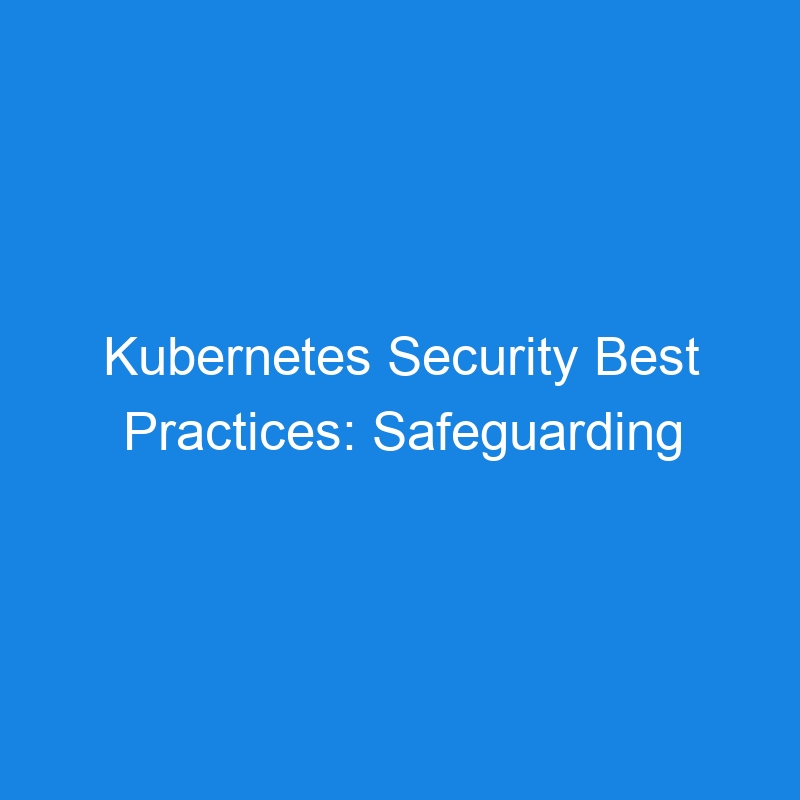Kubernetes Security Best Practices
Kubernetes is a powerful container orchestration platform, but its default configurations can expose clusters to potential security threats. Implementing robust security measures is critical to safeguard Kubernetes clusters and workloads.
This article outlines Kubernetes security best practices, categorized into key areas: Cluster Security, Network Security, Workload Security, Authentication and Authorization, and Monitoring and Auditing.
1. Cluster Security
1.1 Update Kubernetes and Dependencies Regularly
- Use the latest stable version of Kubernetes to protect against known vulnerabilities.
- Keep your container runtime, etcd, and other dependencies up to date.
1.2 Secure the API Server
- Use HTTPS for API server communication.
- Enable Role-Based Access Control (RBAC) to control access to the API server.
- Restrict public access to the API server by using a firewall or private network.
1.3 Use Namespaces for Isolation
- Use namespaces to separate resources by environment (e.g., dev, staging, production).
- Limit namespace access to authorized users and workloads.
1.4 Use Pod Security Standards
- Define policies using Pod Security Standards (PSS) to restrict Pod privileges (e.g., no root containers).
2. Network Security
2.1 Implement Network Policies
- Use Kubernetes NetworkPolicies to control communication between Pods and external systems.
- Restrict unnecessary traffic using “deny-all” as the default policy and explicitly allow only required communication.
Example NetworkPolicy: Restrict Pod Traffic
apiVersion: networking.k8s.io/v1
kind: NetworkPolicy
metadata:
name: restrict-pod-traffic
namespace: default
spec:
podSelector:
matchLabels:
app: my-app
policyTypes:
- Ingress
- Egress
ingress:
- from:
- podSelector:
matchLabels:
role: frontend
egress:
- to:
- podSelector:
matchLabels:
role: database
2.2 Encrypt Data in Transit
- Use TLS encryption for all network communication.
- Encrypt etcd communication with SSL/TLS certificates.
2.3 Use Secure Container Registries
- Use private container registries.
- Enable image scanning for vulnerabilities before deployment.
3. Workload Security
3.1 Use Minimal Container Images
- Use lightweight, secure base images (e.g., Alpine or Distroless).
- Remove unnecessary tools and dependencies from container images.
3.2 Run Containers as Non-Root Users
- Configure Pods to run as non-root users by default.
- Use the
runAsUserandrunAsGroupoptions in the security context.
Example: Configure a Pod to Run as Non-Root
apiVersion: v1
kind: Pod
metadata:
name: secure-pod
spec:
securityContext:
runAsUser: 1000
runAsGroup: 3000
fsGroup: 2000
containers:
- name: my-container
image: my-secure-app
3.3 Limit Container Capabilities
- Drop unnecessary Linux capabilities to reduce the attack surface.
Example: Drop Capabilities
securityContext:
capabilities:
drop:
- ALL
3.4 Use Read-Only File Systems
- Set containers to use read-only file systems unless write access is required.
4. Authentication and Authorization
4.1 Enable Role-Based Access Control (RBAC)
- Define granular roles and permissions.
- Assign roles to users and service accounts based on the principle of least privilege.
Example: RBAC Role
apiVersion: rbac.authorization.k8s.io/v1
kind: Role
metadata:
namespace: default
name: pod-reader
rules:
- apiGroups: [""]
resources: ["pods"]
verbs: ["get", "list", "watch"]
4.2 Use Service Accounts for Applications
- Assign specific service accounts to applications instead of using the default account.
- Restrict permissions of service accounts.
4.3 Use Strong Authentication Methods
- Integrate with secure identity providers using OpenID Connect (OIDC) or similar methods.
- Rotate API keys and access tokens regularly.
5. Monitoring and Auditing
5.1 Enable Audit Logging
- Enable the Kubernetes audit log to track API server interactions and detect suspicious activities.
Example: Basic Audit Policy
apiVersion: audit.k8s.io/v1
kind: Policy
rules:
- level: Metadata
verbs: ["create", "update", "delete"]
5.2 Monitor Cluster Activity
- Use monitoring tools like Prometheus, Grafana, or Datadog to observe cluster performance and detect anomalies.
5.3 Scan Containers for Vulnerabilities
- Use tools like Trivy, Aqua Security, or Anchore to scan container images for vulnerabilities.
5.4 Use Security Dashboards
- Tools like Kube-Bench or Kubernetes Dashboard can provide insights into cluster security and configuration compliance.
6. Additional Best Practices
6.1 Limit Resource Usage
- Use resource quotas to limit the CPU and memory consumption of namespaces.
Example: Resource Quota
apiVersion: v1
kind: ResourceQuota
metadata:
name: namespace-quota
namespace: default
spec:
hard:
pods: "10"
requests.cpu: "2"
requests.memory: "1Gi"
limits.cpu: "4"
limits.memory: "2Gi"
6.2 Protect Sensitive Data
- Use Kubernetes Secrets to manage sensitive information securely.
- Encrypt Secrets at rest using encryption providers.
6.3 Regularly Audit Cluster Configurations
- Perform periodic security audits to identify and fix misconfigurations.
- Use automated tools like Kube-hunter for penetration testing.
Conclusion
Securing Kubernetes clusters requires a combination of proactive measures, monitoring, and best practices. By focusing on cluster security, network policies, workload configuration, authentication, and monitoring, you can significantly reduce the attack surface of your Kubernetes environment.
Implement these best practices to ensure the confidentiality, integrity, and availability of your applications running on Kubernetes.
